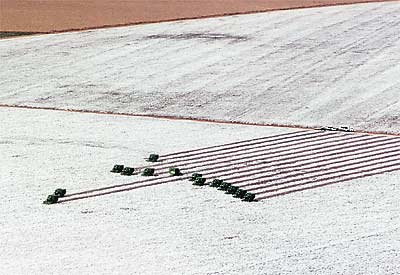|
|
The White Gold Domain the Savannah
01/02/2005
With technology, investment in researches
and organization, producers promote
rebirth of the cotton cultivation
By Fernanda Guirra, of Goiânia

Cotton farming in Mato Grosso: the mechanization allows culture in large scale
After being practically decimated by curses in the middle of the decade of 90, the culture of the cotton was one of the main stars of the Brazilian field again and it is following the trail of success of the soy. The product was what registered larger area growth planted in the last harvest. In agreement with the National Company of Provisioning, the farmings of the fiber already occupy 1 million hectares, from where will be picked on this year 1,2 million of tons-43% more than in 2003. At least a third will have as destiny the external market.
The volume of exports will be 150% larger than last year and 1 500 times superior to the of 1997, when the section lived the peak of the crisis and Brazil became the third world importer of the fiber. Now the country represents between the five larger exporters and are coming heading for the leadership of the world market. The sent bales to the other countries in 2004 should generate an income of 528 million dollars. "After a lot of storms, we got to give the turn for top", commemorate Jorge Maeda, president of the Brazilian Association of the Producing of Cotton.
For several decades, the cotton was one of the main supports of the Brazilian rural economy. It was called then of white gold. Starting from the end of the decade of 80, the production fell drastically, above all because of the propagation of the "bicudo-do-algodoeiro, the beetle that devastated great part of the farmings. The situation still became worse with the opening of the economy to the external market, starting from 1990, that it took to the reduction of the customs duties and it created means for import financings. Those factors, added of the competition generated by the subsidies of the rich countries, they were the main ones responsible for the loss of competitiveness of the section.
The producer from São Paulo Kenjiro Mine: investment in up-to-the-minute technology
Without good profitability, the producers didn't have as investing in modern techniques of production nor in the quality of the fiber. "In the farmings of low productivity, the control of curses became unviable economically", remind the producer Kenjiro Mine, whose family has an improvement plant in the interior from São Paulo and he planted, in the last harvest, 2 700 hectares in Uberaba, on the Triangulo Mineiro, and in Primavera do Leste, on Mato Grosso. Besides forty tractors and nine collecting tractors, the industry improvement of the cotton Mine disposes of six pulverizers of last generation, whose agrotoxics applications are controlled by radar.
The salvation of the cotton farming began to happen in the second half of the decade of 90, when great producers, as Mine industry, decided to introduce the culture in the savannah areas, aided by the development of more resistant seeds to curses and for the intensive use of technology. Ever since, the product, that was just planted in small areas and picked manually, became a culture of wide scale and highly mechanized. The creation of cooperatives and research foundations and the fiscal incentives granted by some state governments contributed also for the retaking of the activity.
The engineer agricultural Gilberto Goellner disembarked in Rondonópolis, on Mato Grosso, in 1982 and, as most of their friends, invested in
Source: Veja Magazine
|

|